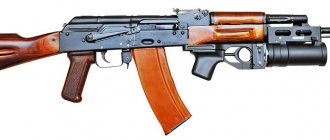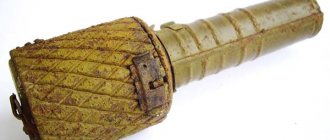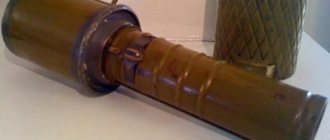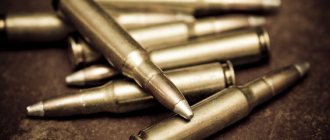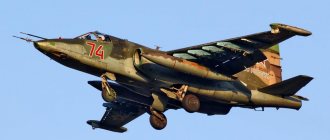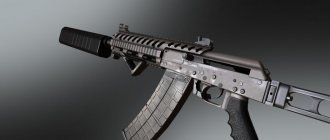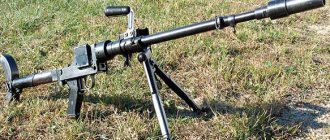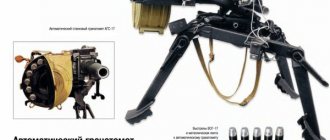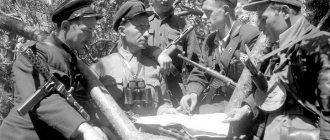Today we are talking about Russian hand grenade launchers. How did famous examples of this type of weapon originate and develop? Top 5 in the article.
Germany and the USA are rightfully considered the creators of the first grenade launchers in the world. It was in these countries that, during the Second World War, fairly effective models were developed for which there was no alternative.
In the Soviet Union, work was also underway to create similar firearms. Back in the 30s, Soviet gunsmiths proposed arming the army with dynamo-reactive guns. Several models were even created, but they never entered service. Then, already at the end of the forties, the first Soviet anti-tank grenade launchers were created on the basis of these guns. But in terms of their tactical and technical characteristics, they were still far from foreign models.
Russian hand grenade launchers: the famous “seven” RPG-7
Success for Russian gunsmiths in this direction came only in 1961, when the RPG-7 hand-held anti-tank grenade launcher was created. It was he who brought Russia to a leading position in this type of weapons. Thanks to its high performance indicators, the RPG-7 has received recognition not only in our country, but throughout the world. If you believe some sources, a plant for the production of RPG-7 is currently being prepared to launch in the United States.
The Russian RPG-7 hand-held anti-tank grenade launcher is designed to disable enemy tanks, self-propelled artillery mounts, and other weapons. In addition, the RPG-7 can be used in urban combat, both to destroy shelters and manpower.
Structurally, the RPG-7 consists of a barrel (pipe and pipe), trigger and striker mechanisms, a fuse, mechanical (on the barrel) and optical sights.
The pipe and pipe of the Russian RPG-7 hand grenade launcher are rigidly fastened and serve not only to direct the shot, but also to remove powder gases. In another modification of this grenade launcher, RPG-7D, the pipe and pipe have a crack joint in the form of grooves on the pipe and corresponding protrusions on the pipe, which are fixed with latches. Thanks to this, the RPG-7D is more convenient when landing personnel or during forced marches over long distances. In addition, this modification has a modified safety mechanism, which eliminates the possibility of an accidental shot if the connection between the pipe and the barrel nozzle is not tight.
The RPG-7 is still one of the best grenade launchers in the world, and is not inferior in its characteristics to more modern models. Russian grenade launchers: RPG-18 “Mukha” This is the first domestic disposable grenade launcher. Based on the results of tests in 1971, the RPG-18 anti-tank rocket grenade system was adopted by the Soviet Army.
The “Mukhi” device consists of a telescopic structure that has an outer and an inner pipe. The first is made of T13 fiberglass, and the second is made of aluminum alloy. The RPG-18 can be fired at a distance of 50 to 200 meters.
History of creation
The first type of weapon that to some extent resembled a grenade launcher was hand-held mortars. They appeared at the turn of the 15th and 16th centuries. The unknown inventor of a new weapon for those times simply replaced the small cannonball that was used to load the squeaks with a grenade loaded with black powder. Hand-held mortars can be seen today in many museums, however, they usually did not find wide use among the troops. In the Russian army during the reign of Peter I, this weapon was introduced as a means of self-defense for artillerymen, but was then considered unsuitable for field battles.
Several different versions of a hand-held mortar - a prototype of a grenade launcher
The low efficiency of hand-held mortars was due to very strong recoil: they had to shoot while resting the back of the barrel on the ground or on the deck of a ship. In essence, this weapon was more like a small mortar. In addition, grenades of those times had a low destructive effect.
Another prototype of a modern grenade launcher was a gun patented in 1718 by London lawyer James Puckle. This invention can also be considered an early ancestor of the machine gun or even the automatic shotgun. The “gun” was equipped with a quick-change drum, which housed 11 ready-to-fire charges. The caliber is large enough to replace the large bullets proposed by Pakl with small grenades. Contemporaries did not appreciate the invention: it was too complex for the 18th century.
"Pakla's Gun" in the museum. It is clearly visible that the charges are not inferior in size to grenade launcher rounds
At the beginning of the twentieth century, the old idea of a hand-held mortar was returned, but at a qualitatively different level. The first muzzle grenade launchers appeared, which were a shortened rifle with a primitive launcher attached to it. The most widespread, however, were homemade products made right in the trenches of the First World War. Sometimes soldiers took an ordinary hand grenade, soldered an old ramrod to its bottom, and then inserted the resulting structure into the barrel of a rifle and fired with a blank cartridge.
Soon the production of such muzzle grenade launchers was, as they say, streamlined - homemade products disfigured rifle barrels, so it was more expedient to use special overhead devices.
The simplest rifle grenade from the First World War.
A regular ramrod is soldered into the back. In World War II, tanks quickly became the main type of weapon. The infantry initially did not have effective means of destroying armored vehicles. Anti-tank rifles could be seen as a temporary measure due to extreme necessity. This situation changed only after the advent of anti-tank grenade launchers. Already their first models, such as the American Bazooka or the German Panzerfaust, significantly increased the vulnerability of armored vehicles.
In the post-war years, anti-tank grenade launchers were actively improved. A particularly successful model was the Soviet RPG-7, which is still in use today, and in terms of its prevalence in different countries of the world is comparable only to the Kalashnikov assault rifle. At the same time, the United States was implementing an ambitious program to create new types of infantry weapons and ammunition, known by the acronym SPIW (Special Purpose Individual Weapon). Part of it was the NIBLICK project, within the framework of which a fragmentation grenade with a caliber of 40 millimeters was developed.
American grenade 40x46 mm. Used in under-barrel and hand-held grenade launchers, it became the prototype of a shot for an easel automatic grenade launcher
This ammunition later made it possible to create several new types of weapons at once:
- Light infantry grenade launcher. Both single-shot and multi-shot models are available;
- Underbarrel grenade launcher. Attaches to an assault rifle and significantly expands its capabilities;
- Automatic easel grenade launcher. A powerful infantry support weapon. Capable of firing in bursts.
Later, at the turn of the 60-70s of the last century, similar systems appeared in the USSR.
Recently, the development of grenade launchers has been going in two main directions. The first of them is building up and expanding the capabilities of anti-tank models. The second is the improvement of small-caliber fragmentation grenades. The American promising OICW complex managed to increase the flight range of such ammunition to 2000 meters.
RPG-26 "Aglen"
The principles of use of this disposable grenade launcher system are the same as those of the RPG-7. “Aglen” is a thin-walled pipe, which is made of the same grade of fiberglass as the RPG-18. The trigger mechanism has a stand that puts the mechanism on safety (lowered down) or cocks the trigger (raised up). In addition, this stand is part of the scope. "Aglen" has a firing range from 50 to 250 meters.
Device
Like the RPG (anti-tank hand grenade launcher), the Spear LNG is presented in the form of a system in which the initial velocity is transferred to the grenade as a result of combustion of a gunpowder charge in the barrel channel. When the starting charge burns, the resulting gases begin to press on the grenade, which is then driven to maximum speed by its jet engine. The easel grenade launcher fires PG-9 grenades. This ammunition has a caliber warhead, which has a piezoelectric fuse and a jet engine. The latter contains a six-blade stabilizer and two tracers. The starting charge is equipped with a metal charger in the form of a perforated tube, a sample of nitroglycerin-based gunpowder, a boost unit and a DRP ignition charge, which uses an electric igniter.
RPG-29 "Vampire"
The Russian Vampire hand grenade launcher was put into service in the late 80s. Along with the RPG-7, it is a modern weapon capable of hitting various armored and non-armored targets, enemy personnel and various structures. Compared to the RPG-7, the Vampire has a larger mass and, accordingly, dimensions. However, this does not in any way reduce its tactical and technical characteristics in various climatic conditions.
For ease of transportation, the RPG-29 can be disassembled into two parts. The grenade launcher is equipped with a trigger with a handle, a mechanical sight and a thrust bipod. In addition, the Vampire package includes an optical sight and a night vision device, which allows you to make the most accurate shots at any time of the day.
AGS-30
An automatic mounted grenade launcher was developed in the early 1990s. engineers of the Instrument Design Bureau in the city of Tula. The designers were given the task of creating a new grenade launcher to replace the AGS-17 model. Serial production has been carried out since 2008 at the KZTA JSC enterprise. The automatic grenade launcher operates using the recoil energy of the bolt. In order to give the gun stability during firing, a special tripod machine was developed for it.
According to experts, the AGS-30 can be used from any surface and unprepared position. The grenade launcher can be disassembled for transportation in 3 minutes. A weapon with optical and mechanical sights. The AGS can also be connected to a portable radar system. Shooting at long distances is carried out using PAG-17 optical sights, which have a 2.7-fold magnification. The grenade launcher is equipped with 350-gram VOG-17 rounds. The mass of the explosive is 36 g. At the point where the grenade falls, the area is affected within a radius of 70 m2. The upgraded VOG-17M rounds are equipped with fuses with self-liquidators. This mechanism begins to work 25 seconds after the shot under the influence of a pyrotechnic moderator. In VOG-30, the weight of the explosive is increased to 185 g.
In an effort to increase the destructive impact of fragments, designers use the cold volumetric deformation method in the production process. Thus, half-finished fragments are formed on the inner surface of the body. In VOG-30, the presence of a fragmentation jacket as a separate part is not provided. As a result of the increase in explosives, the affected area increased - 110 m2. This figure is increased to 131 m2 with the GPD-30 with a total mass of 340 g and an explosive of 185. During testing, it was noted that drag and ballistics were reduced by almost half. This, in turn, had a positive effect on the projectile’s flight range. Such a grenade can hit a target at a distance of no more than 2200 m. In addition, the accuracy of the battle has been improved by one and a half times.
Russian hand grenade launchers: RG-6
The RG-6 hand-held revolving grenade launcher was developed in 1994 and in the first quarter of the same year, six samples were already tested. For its structural simplicity and high efficiency, the weapon was received with a bang by the military. The RG-6 consists of a pipe with a handle, a cover, sighting devices, a barrel drum, an axial housing, a trigger with a pistol handle and a retractable butt.
RG-6 when assembled is a disk-shaped box. The RG-6 hand-held revolving grenade launcher has proven itself not only in field tests, but also in real combat. In particular, special forces used it on the territory of Chechnya during the war.
These were Russian hand grenade launchers - photos and brief description.
RShG-2 assault rocket grenade launcher
Also known as the Basalt project. In service since 2003. Such Russian grenade launchers are single-shot. There are three types of ammunition: fragmentation, high-explosive and incendiary.
Jet weapons are designed to destroy unarmored or lightly protected vehicles, infantry and enemy fire weapons. Suitable for combat in trenches and indoors. Precision shooting is ensured at a distance of up to 350 meters. Such an impressive result is achieved thanks to the thermobaric impact mechanism. Caliber – 72.5 mm. The net weight of the weapon is only 3.8 kg with a length of 0.77 m. The unhindered flight speed is 144 m/s.
Baryshev ARGB grenade launcher - video
For indirect fire, the ARGB grenade launcher is equipped with an optical sight with a side level and a protractor mechanism, a removable bipod and a folding buttstock. Almost all the advantages of the ARGB, characteristic of the KPB machine gun, are fully embodied in the Baryshev manual automatic grenade launcher. In terms of weight and size characteristics, the ARGB is significantly ahead of all known automatic grenade launcher systems.
Baryshev’s weapons belong to the automation systems that use a semi-free shutter for operation. All samples of these weapons have very unique locking units, created according to a single design. Their peculiarity is that, along with their main function, they also provide partial absorption of the recoil energy of the weapon, since the bolt parts - the combat cylinder, the bolt frame, the bolt frame and the locking lever - are not rigidly connected to each other, so a significant part of the recoil energy during shot is spent on sequentially setting them in motion, which, in turn, due to the collision of moving elements and the extension of their action over time, significantly, at least 2.5-3 times, reduces the recoil force. Reducing the recoil force acting on the shooter during a shot made it possible not only to increase the accuracy of shooting in the mode of automatic fire in continuous bursts, but also at the same time to reduce the weight of the weapon by 2-3 times, and also to use any types of small arms ammunition, starting from low-pulse machine guns and ending with powerful grenade launcher shots. While maintaining accuracy of fire, this made it possible to avoid installing such weapons on complex and heavy machines and to make do with a simple and lightweight bipod.
The ARGB grenade launcher fires from the so-called rear sear, i.e. The moving parts of the automatic are in the rear position before firing, and there is no cartridge in the unlocked chamber. This design solution is more typical for submachine guns, machine guns and automatic cannons. The ARGB grenade launcher has a magazine feeding system with 30-mm VOG-17 grenade launcher rounds, which has a positive effect on significantly improving its maneuverability.
The ARGB can be used as a very powerful fire support weapon for a motorized rifle unit. Such weapons are indispensable for direct fire support of infantry, especially in offensive combat, in combat operations in difficult conditions: in populated areas, in trenches, in the mountains. Reducing the weight of the weapon designed by Baryshev, among other things, made it possible to reduce the crew from 2-3 people to one shooter and dramatically increase its maneuverability.
The grenade launcher also fully revealed the advantages of the Baryshev system's semi-free bolt, allowing for fairly effective automatic fire with powerful shots from unstable positions while moving and standing from the hip at a range of 400-500 m.
The indisputable advantages of the new system include the abandonment of the gas engine (gas piston, gas chamber and gas outlet paths), which significantly simplified and made the design of the weapon cheaper and improved its performance.
When firing from an ARGB, the recoil is felt no more than when firing from a 40-mm GP-25 under-barrel grenade launcher mounted on a machine gun. When shooting from stable positions (lying down from a bipod), a significant part of the recoil is effectively absorbed by the shock absorber built into the butt, thus increasing the accuracy of the battle.
User Notes:
ARGB - here, of course, the recoil is serious, but the weapon can be serviced by one crew number and is much more mobile than the AGS-17 and AGS-30, especially when fighting in the city and when entering battle on the move.
ARGB - on the 80th shot, grenades began to underfire, misfire and delay due to tight extraction. Well, you can put up with this - either the grenade launcher will be killed on the 20th shot, or he will complete his task and go quietly clean the grenade launcher. All wedges and poor automatic operation stem from the principle of locking the barrel bore.
Locking system - it consists of a combat cylinder, a massive bolt frame, a bolt and a lever. During a shot, the powder gases press on the bottom of the cartridge case, the bottom presses on the shutter mirror located on the combat cylinder and rotates it at an angle of 4-5 degrees. The larva, in turn, presses on the bolt frame and pushes it back. The bolt frame travels a certain distance and presses on the lever, disengaging it from the lug lug of the barrel insert, releasing the cylinder and the bolt and takes them all along with it, simultaneously extracting the cartridge case with the ejector located on the cylinder. Then the cartridge case hits the reflector and flies out through the cartridge ejection window (sometimes directly at the shooter, sometimes forward, sometimes sideways and down - unpredictable. Although most often it flies to the right side and up).
When this whole thing moves back, under the action of the reciprocating mainspring, the next cartridge is sent into the chamber and the circuit is assembled in the reverse order of unlocking.
The main control part of the automation is the combat cylinder of complex geometric shape, the leading part is the bolt frame. The cylinder is also low-tech (requires a wide range of shaped cutters) and difficult to produce. Well, to hell with it, with production, but it is also very difficult to heat treat and requires scarce steels. Also, often after 2 - 3 thousand the bolt frame breaks at the point of contact with the lever and it also has to be made from expensive and scarce steel.
Also, due to the peculiarities of the locking system, the shooter first feels a push at the moment the cylinder rotates and then the impact of the bolt frame in the rearmost position. This has a bad effect on the quality of aiming.
Other parts of the weapon require individual adjustment due to a particularly complex geometric shape; the system does not work with large gaps between the moving parts, which is why even with slight clogging, it jams due to thermal expansion of the weapon parts. Baryshev took the scheme from aircraft guns, only they are serviced by more qualified personnel than conventional army small arms and work under different conditions. And their service life before average repair is less than that of army small arms. The conclusion is this: the weapon is unsuitable for linear units; it is necessary for special forces, where fire contact is fleeting, greater maneuverability of powerful small arms is required, and the warrior is well trained, intellectually developed, proactive and daring in battle.
